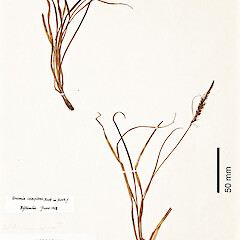Carex astricta
Common name
bastard grass, hook sedge
Synonyms
Uncinia caespitosa Boott, Uncinia caespitosa Boott var. collina Petrie
Family
Cyperaceae
Flora category
Vascular – Native
Endemic taxon
Yes
Endemic genus
No
Endemic family
No
Structural class
Sedges
NVS code
The National Vegetation Survey (NVS) Databank is a physical archive and electronic databank containing records of over 94,000 vegetation survey plots - including data from over 19,000 permanent plots. NVS maintains a standard set of species code abbreviations that correspond to standard scientific plant names from the Ngä Tipu o Aotearoa - New Zealand Plants database.
UNCCAE
Chromosome number
2n = 88
Current conservation status
The conservation status of all known New Zealand vascular plant taxa at the rank of species and below were reassessed in 2017 using the New Zealand Threat Classification System (NZTCS) – more information about this can be found on the NZTCS website. This report includes a statistical summary and brief notes on changes since 2012 and replaces all previous NZTCS lists for vascular plants.
Please note, threat classifications are often suggested by authors when publications fall between NZTCS assessment periods – an interim threat classification status has not been assessed by the NZTCS panel.
- Conservation status of New Zealand indigenous vascular plants, 2017 . 2018. Peter J. de Lange, Jeremy R. Rolfe, John W. Barkla, Shannel P. Courtney, Paul D. Champion, Leon R. Perrie, Sarah M. Beadel, Kerry A. Ford, Ilse Breitwieser, Ines Schönberger, Rowan Hindmarsh-Walls, Peter B. Heenan and Kate Ladley. Department of Conservation. Source: NZTCS and licensed by DOC for reuse under the Creative Commons Attribution 4.0 International licence.
2017 | Not Threatened
Previous conservation statuses
2012 | Not Threatened
2009 | Not Threatened
2004 | Not Threatened
Distribution
New Zealand: North Island, South Island and Stewart Island/Rakiura from about the Hauhangaroa and Raukumara Range south.
Habitat
.Montane forest, forest margins and damp sites within grassland. Descending to sea level in southern part of its range
Detailed description
Weakly tufted, dark green to yellow-green plants. Culms 40–400 × 0.5–1.0 mm, glabrous; basal bracts dull dark brown or chestnut-brown. Leaves 6–11 per culm, ≤ culms, 2–4 mm wide, rather stiff, often curved, dark green to yellow-green, rather flat but with midrib evident on abaxial surface, scabrid on margins and adaxial surface. Spikes 25–90 mm long, often bracteate, subclavate, 4–5 mm diameter in the female portion of spike, male portion more slender, usually conspicuous, c. 2 mm diameter and ¼–⅓ the length of the whole spike; female flowers 10–35, almost all closely crowded, internodes 1–5 mm long. Glumes > utricles in lower part of spike, = utricles above, deciduous, ovate or subulate, acute or acuminate, membranous, greenish brown or light brown, usually striated, midrib green with 3 distinct nerves, later becoming dark brown. Utricles 5.0–7.0 × 1.5–2.0 mm, trigonous, broadly ovoid, 1.0–1.5 mm long, beak 1–2 mm long.
Similar taxa
Carex astricta shares with C. crispa K.A.Ford and C. horizontalis (Colenso) K.A.Ford brownish glumes which in the lower part of the spike are longer than the utricles. It differs from Carex crispa by its virtual restriction to forested habitats, by the leaf apices which are flat rather than curled/twisted (cirrhose) and by the dull rather than shiny utricles. From Carex horizontalis it differs by its preference for forested rather than tussock grassland and herbfield habitats, yellow-green to dark-green rather than bright green leaves with flat, rather than v-shaped leaf apices, and spikes which are greater than 40 mm long rather than 30 mm or less.
Flowering
October–November
Fruiting
November–April
Propagation technique
Easily grown from fresh seed and by division of established plants, though these may take a while to settle. Prefers moist soil in a a semi-shaded site. However, once established will tolerate a wide range of conditions except waterlogging.
Etymology
carex: Latin name for a species of sedge, now applied to the whole group.
Where To Buy
Not Commercially Available.
Attribution
Description adapted from Moore and Edgar (1970). Fact sheet prepared by Peter J. de Lange 17 August 2006.
References and further reading
Moore LB, Edgar E. 1970. Flora of New Zealand, Volume II. Indigenous Tracheophyta: Monocotyledones except Gramineae. Government Printer, Wellington, NZ. 354 p.
NZPCN Fact Sheet citation
Please cite as: de Lange, P.J. (Year at time of access): Carex astricta Fact Sheet (content continuously updated). New Zealand Plant Conservation Network. https://www.nzpcn.org.nz/flora/species/carex-astricta/ (Date website was queried)




